The Bonnet Carré Spillway is flowing two years in a row, a first in its entire history. Let's take a look at how bad it's going to be for inshore anglers in its path.
How Bonnet Carré Will Affect Inshore Fishing For 2019
By now the Army Corps of Engineers has opened the flood control structure that we inshore anglers aren't particularly fond of.
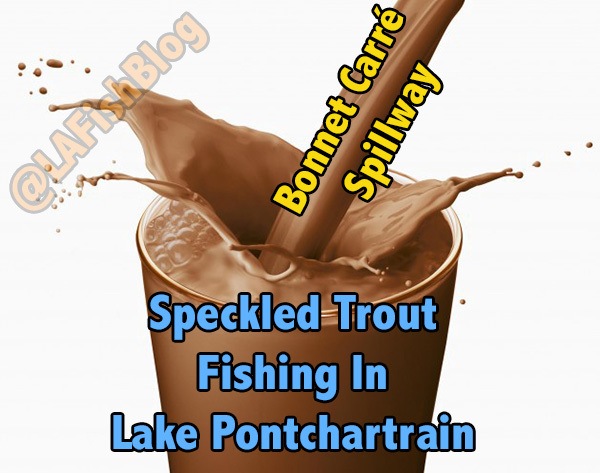
You can't blame us, river water is a surefire way to shut down any trout action we've been hoping for this spring.
Not that we didn't have a good winter, but we do look forward to that awesome spring-time bite for speckled trout on the bridges of Lake Pontchartrain.
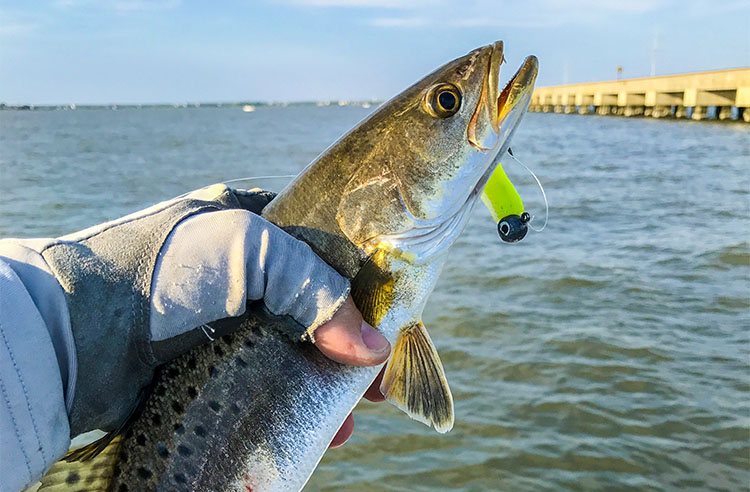
A hot bite at the Trestles is an excellent fishing experience!
Quick Recap On River Water (and why it's bad)
Maybe you're a newcomer to inshore fishing and wonder why this spillway opening is making us groan in pain.
In short, river water is bad for inshore species, not because it dilutes saltwater (redfish do fine in freshwater and speckled trout thrive in extreme low salinity) but because the dirty water is tough on fish not adapted to it.
The suspended silt irritates their large eyes and thin gill plates, ultimately causing them to leave the area.
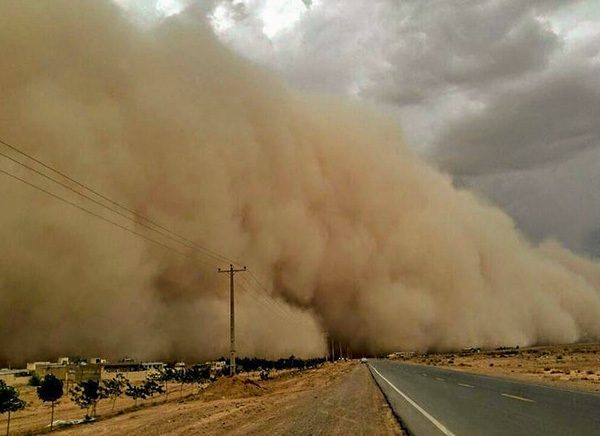
What this sandstorm is to people, muddy river water is to speckled trout and redfish.
Plus, redfish (adults over 27") and speckled trout cannot spawn in water that's so fresh.
So river water will push them away to saltier destinations during their spawn, not unlike what happened with this big trout.
This Time It's Worse
River water flooding from the spillway into Lake Pontchartrain is nothing new, it's happened a dozen times before.
What is new is the fact that this opening is the first one to happen two years in a row.
That's right, the spillway was opened last year, seriously freshening the Pontchartrain Basin, and it's pouring right now!
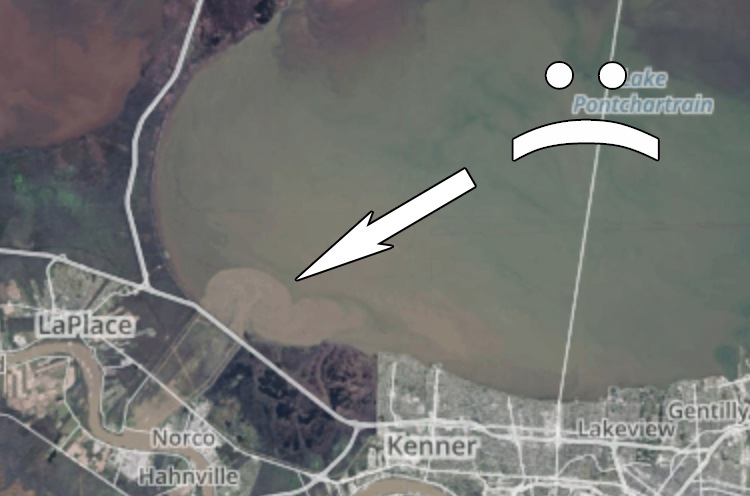
Last year's spillway opening in action, as seen from the sky.
While it wasn't opened the year before, it ran for 22 days (with 210 of 350 bays open) back in January 2016.
That same year we had historical 500 and 1,000 year floods from the Amite, Tchefuncte and Pearl Rivers, so it's safe to say that Lake Pontchartrain has seen as much river water as she ever has since the MRGO was dug.
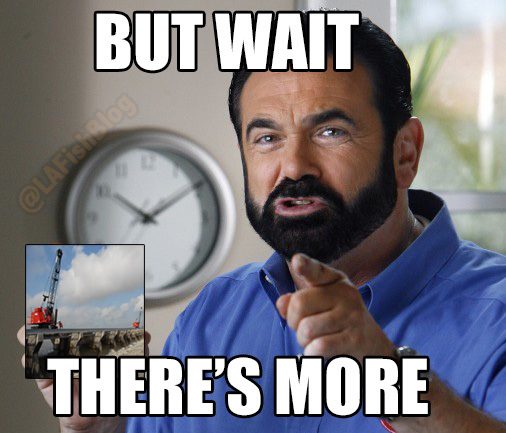
But Its Gets Worse
There's a monumental amount of water coming down the pipe.
Dams in the Tennessee river are spilling over and emergencies have been declared in both Kentucky and Mississippi.
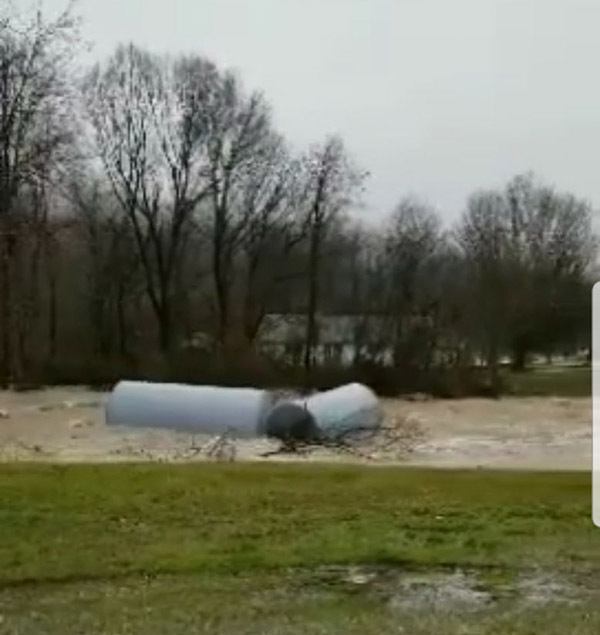
My uncle in Tennessee sent me this screenshot of two 500 gallon drums swept away near the Tennessee River. All that water is headed here.
And It Will Grow Worse Yet
North of us (like...way past the Mason-Dixon line) freezing temperatures still linger, leaving snow on the ground.
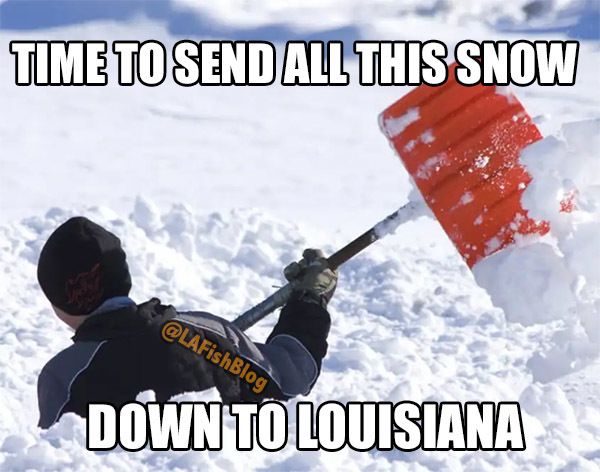
Snow that will eventually melt into water...
...water that will eventually flow our way...
...and out the Bonnet Carré Spillway.
(did not intend for that to rhyme)
Remember This Important Thing
The only constant is change, and nothing has ever stayed the same but that very thing, especially when it comes to Louisiana's wetlands.
If this river water proves anything, it's exactly that.
Furthermore, we'll see which inshore anglers are able to handle that change, and that will be evidenced by who brings home the boxes of redfish and trout, and those who do not.
How Will Inshore Fishing Be Affected This Year?
By now the Bonnet Carré Spillway has been roaring for a bit, dumping massive loads of trout repellent into Lake Pontchartrain.
Obviously this isn't ideal, but it's worth taking a closer look at the overall impact of this record-setting opening.
After all, seeing the bigger picture is what smart inshore anglers do to keep catching when everyone else is whining about the spillway.
How Bad Will This Hurt Our Fishing?
It really depends on how long the spillway is open and how hard it flows.
There are 350 bays total, and they are rarely all opened at once, with 1983 being the last time that happened.
How Hard?
According to this bulletin at Louisiana Maritime, there are 148 bays flowing at 133,000 cubic feet per second, or cfs.
Bonnet Carré's max output is 250,000 cfs.
How Long?
Furthermore, according to this article, the Army Corps plans on operating the spillway until the end of this month.
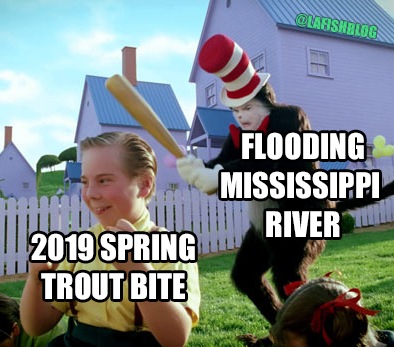
It's safe to say (you may want to sit down) the spring run of speckled trout in Lake Pontchartrain isn't going to happen.
Even with last year's opening I remained optimistic, but the trout never really arrived in force and, with the current opening taking place, there's no reason to pretend otherwise.
The Trout Spawn Will Be Affected, Too
Speckled trout need, at a minimum, 15 - 17ppt saltwater to spawn.
If they don't, they will keep swimming until they do.
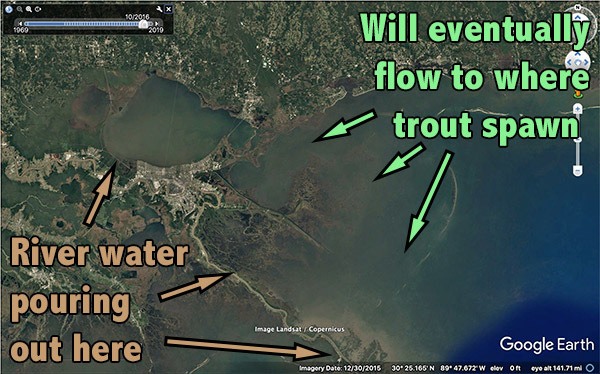
Places available for spawning during saltier times (i.e. Rigolets Pass, Mississippi Sound) may not be viable at all this summer.
Even last summer I found it difficult to find a good trout bite without making a long run outside of the marsh.
Redfish Will Be Fine
Given that some of the best redfish action is had near river water, I'm sure our favorite marsh donkey will do just fine, especially considering the increase in cover for themselves and their forage.
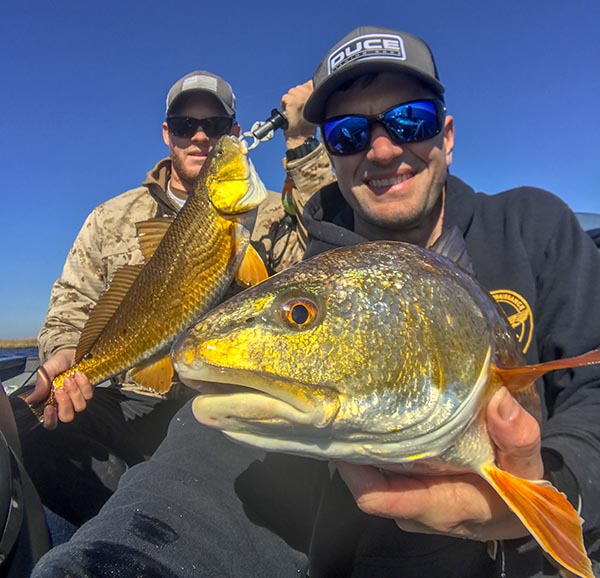
More Grass Will Grow
Areas saturated with freshwater (especially those near the Mighty Mississippi) tend to grow aquatic grasses in places they would not if the salinity were higher.
Grass is good! It provides a place for forage to feed and hide, and acts as a "filter", cleaning water that flows through it with the tide, just like what you see in this video.
But Pray For Saltwater Anyway
I think our inshore fishing in Louisiana is great due to river water, but only when it mixes with saltwater from the Gulf of America.
Our awesome inshore fishery is like a tasty cocktail, blended with saltwater from the Gulf of America and river water from the Mississippi and Atchafalaya rivers.
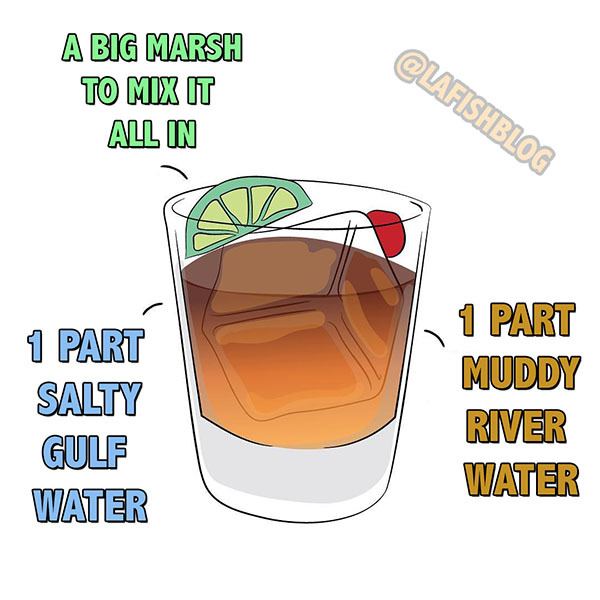
But what happens when the ingredients are out of balance?
It makes for a not-so-tasty cocktail and, in our case, tough fishing.
Simply put, without the right amount of saltwater, our "inshore cocktail" is going to see major changes in fishing patterns with this major influx of river water.
Keep That Good Attitude
I see a lot of y'all on social media and am pleased to see inshore anglers with a good, upbeat attitude.
Yes, there are the Debbie Downers and Negative Nancies, but that's life and we're all better off ignoring them.
This is Louisiana, a great state with an awesome fishery that has been through a lot worse than this.
Is There Anything Positive To The Bonnet Carré Spillway Opening?
Yes! There are a few things:
Plan Redfish
Redfish are a "go to" when the fishing gets tough and there are plenty of them in the marsh to keep us busy until fall arrives.
They're still there, will always be there, and the proliferation of aquatic grasses makes fishing for them easier.
Trout Could Get A Break
Speckled trout need at least 17ppt saltwater to spawn and, as a reference, full strength saltwater is 35ppt, and we find trout wintering in saltwater as low as 2-3ppt.
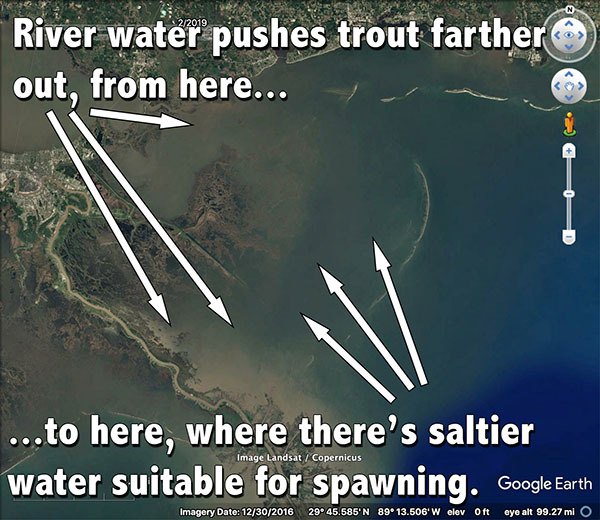
The problem is that approaching river water dilutes salinity closer to land, pushing that required 17ppt further away from the marsh...
...to spots not protected from the wind...
...to the same spots you need the weather to cooperate if you ever hope to reach them.
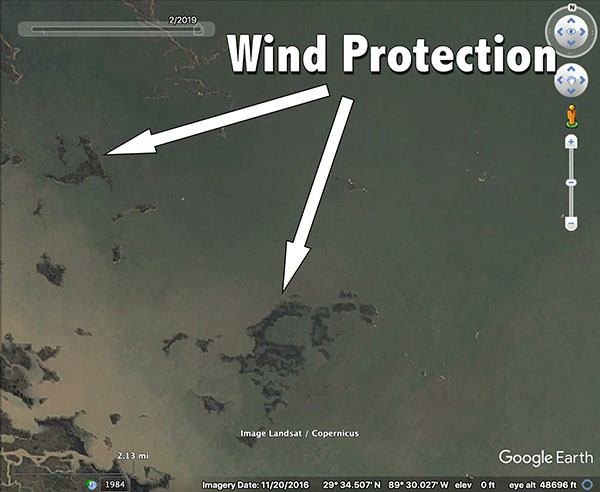
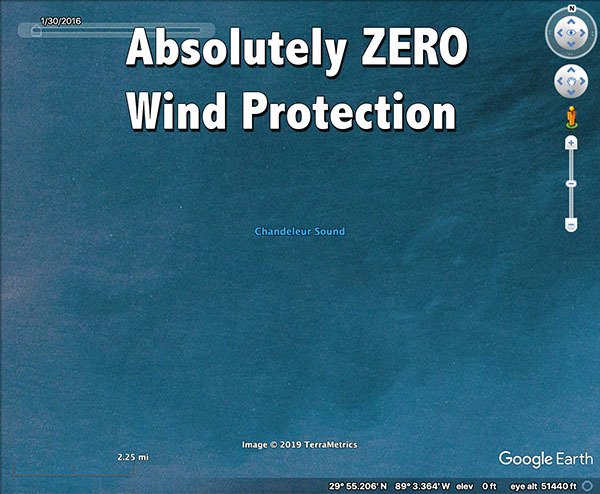
With fewer anglers able to access them during the spawn, trout very well could get a break from fishing pressure.
What does this mean?
We could see higher levels of recruitment since they can spawn before being caught.
That and trout can grow bigger, since they're not being caught.
And the day will eventually come that salinity levels rise...
Note to Non-Louisiana Readers
Caught and kept are virtually synonymous in Louisiana, where our creel limits are geared towards maximum yield, and catch and release is not widely practiced.
We have a food culture here (hey, folks come from all over the world to try our cuisine!) and keeping limits of speckled trout (25 per angler, per day) is widely accepted, all to feed family and friends with awesome food.
Not dinging on anyone here, just wanted to clear any confusion.
Bass-plosions
With the onslaught of more river water, we could see an improved bass bite in the marsh.
This would come on top of the "bass-plosion" we've already seen with "the freshening" of the marsh due to 2009's MRGO closure and the record amount of river water in the last few years.
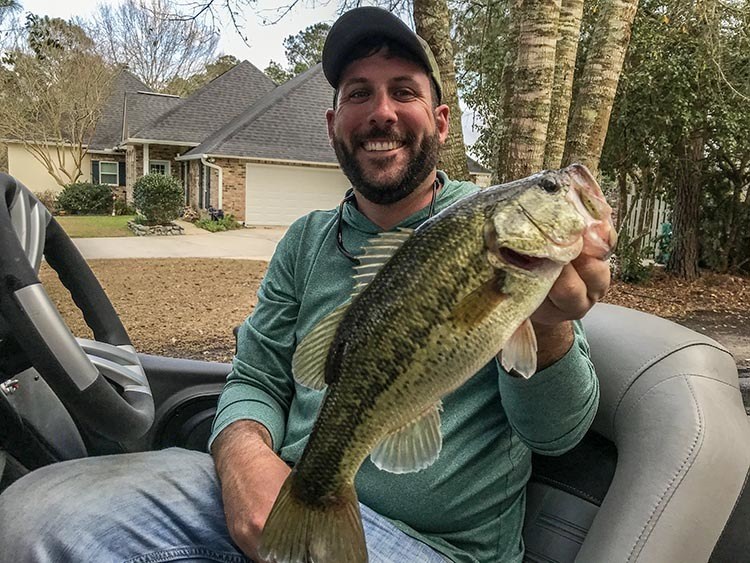
With that said, unless we start consistently catching fish heavier than three pounds, I can't get that excited over marsh bass, though there are certainly large numbers of them.
Exactly how big are our marsh bass?
Louisiana Department of Wildlife and Fisheries electrofishes places like Caernarvon and Bayou Bienvenue to determine the number and health of largemouth bass in those areas.
You may view their findings in this report here.
If I am going bass fishing, I'd rather go where there's an established Florida-strain population and grind for some real hammers, places like Lake Conroe or Chickamauga.
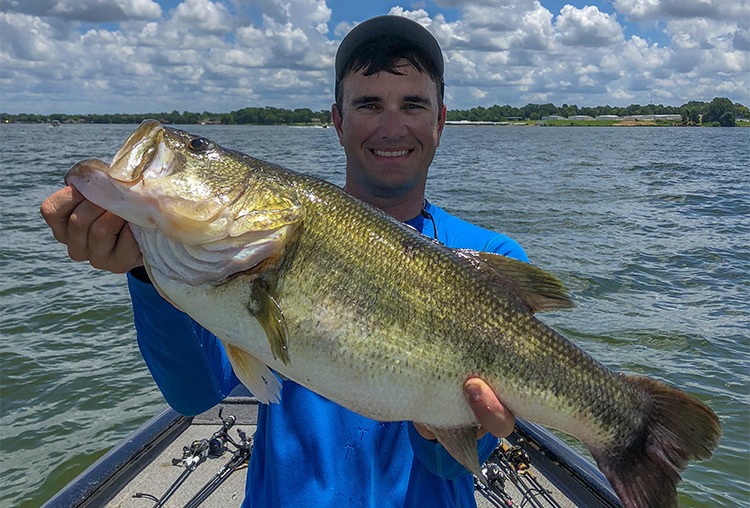
With that said, let me tell you this: if you've never had a great day of froggin', then you've never had a great day of topwater action.
The best, most fun, topwater action I've ever been on was in complete freshwater, pulling hawgs out of thick, matted grass on the Tennessee River.
But it gets better: redfish are absolutely bonkers for frogs!
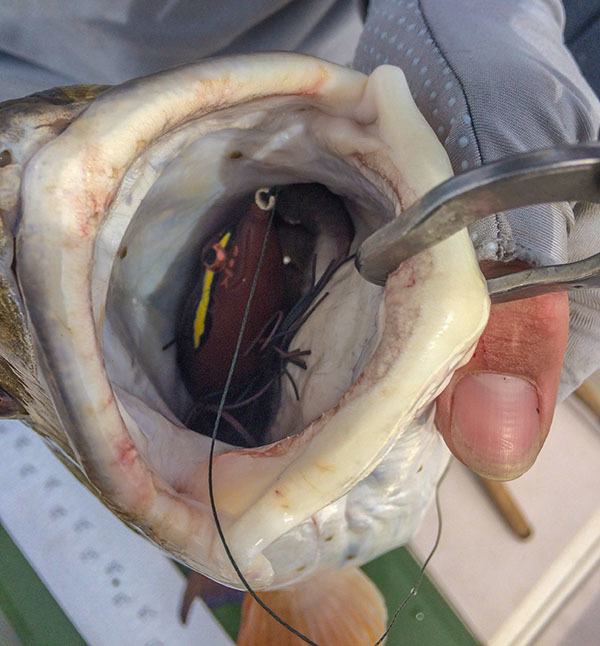
It's a great topwater bait to fish thick grass with and I've witnessed reds bang U-turns in a pond to suck one down.
It's safe to say that a good frog bite is viable in our abundant inshore marshes.
Great Speckled Trout Fishing Will Happen
Yes, speckled trout fishing as we knew it has been put on hold, but mark my words:
When the rivers get super low, if there is a drought, the speckled trout fishing will light on fire.
The best trout years we've had always came on the heels of drier weather, and that's something we have to look forward to.
Now let's jump into exactly what can be done to adjust to the river water pouring from Bonnet Carré Spillway.
Catching Speckled Trout Near River Water
It's springtime, the time of year trout begin noticing warming water temps and longer days.
If it hasn't already, their urge to spawn is kicking in and they've begun moving outside of the marsh towards saltier water.
Why saltier water?
Speckled trout need salinity to be at least 15-17ppt in order to successfully spawn.
This is because fertilized trout eggs depend on the higher salinity to float and not become smothered at the bottom of the water column.
Given this pattern, I think we will find speckled trout in their usual springtime haunts, just not the ones covered in river water.
How to avoid river water?
Speckled trout don't mind low-salinity water (in fact, they thrive in it) but don't want to spend their time in river water because it's tough on their eyes and gill plates.
It would be really good to know where river water is before going fishing, right?
Well, how do we obtain this information?
Easy! By using daily satellite imagery to see a picture of Louisiana as seen from space.
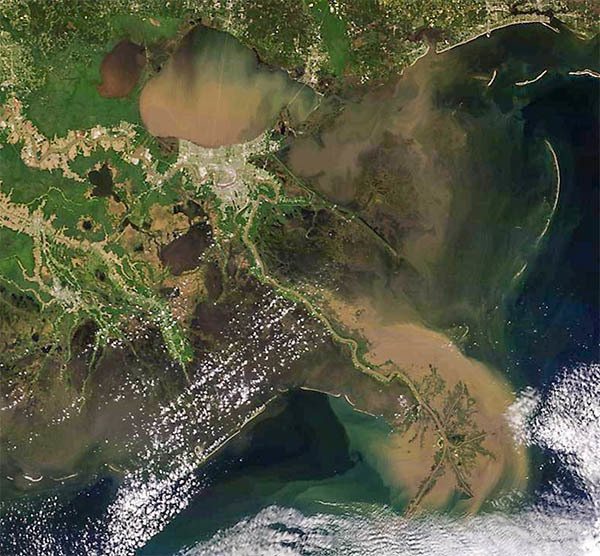
Want to learn more about where to find this resource and how to use it? Just click here.
But What About Redfish?
Also a favorite of Louisiana's inshore anglers, redfish are great to have in your back pocket because of their dependability.
In fact, they do great in not just low-salinity, but also straight freshwater.
This is good because regardless of how much river water there is we can depend on finding them somewhere nearby.
This article on finding awesome redfish spots is a great start, as well as this one about catching redfish in dirty water.
See How I Do It
It's really great, and anglers love it, which is why I encourage you to join today.

Not any different from what’s in this post and the subsequent ones.
So what are your thoughts on The Morganza Spillway and Grand Isle?
Me and you both, but I don’t see anything forecasting otherwise.
It’d be nice to get east wind like we did in June 2012.
Here’s the thing, if an area stayed fresh, and grew an awesome freshwater fishery (like Cataouatche back in the day) then I could accept that.
If it stayed saltier, and had an awesome saltwater fishery (like when we were catching lots of flounder) then I’d be dandy with that.
But this going back and forth with pea soup is getting old.
I’m accepting it as a “phase” and that river levels will eventually go down, and stay down, and then it will be on like Donkey Kong.
If it is anything like the last few years we will have persistent west winds to go along with the high rivers. Then we will hear people cry the guides are killing all the trout and limits must be reduced or guides eliminated. I sure hope I am wrong, but mark my words.
It really depends on what happens.
We could get a string of east wind to push in saltier water, or we may not.
Ultimately time will tell, but if I were you I’d keep Plan Redfish in my back pocket.
Thanks for commenting!
Thanks for the Info. Capt. Since we moved, I’ve planned a trip the 2nd week of April to come fish down there.
This makes me think immediately, we might be looking to fish further east(Biloxi Marsh)? Pending all other conditions 1st of course.
Looking forward to your analysis in Part 2!